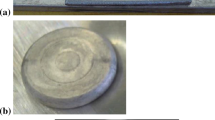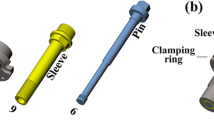Abstract
Magnesium alloys have a significant benefit over steel and aluminum alloys in manufacturing components for many automotive and structural applications because of their higher light-weighting potential, lowest density, and higher strength to weight ratio. However, one of the impediments to the success of multi-material integration of the above materials for automotive manufacturing is joining these materials together without any cracking or corrosion during in-service use. The present work aims to develop and demonstrate a cost-effective, novel, and versatile mechanical joining technique, named Upset Protrusion Joining (UPJ), to mechanically and rapidly join a cast magnesium component to an aluminum alloy sheet. The process involves a cylindrical protrusion emanating perpendicular to the flat surface of a cast plate that fits through a hole in an aluminum sheet. The two components are then clamped together, electrically heated, and compressed perpendicular to the protrusion axis. During compression, the protrusion expands circumferentially to fill the hole as well as the region above the hole, thus entrapping the sheet metal between the mushroomed head and the casting. The effect of different UPJ process parameters such as applied current, current duration, compression loading rate, and compression distance were studied through experimentation on die-cast magnesium alloy, with protrusion of 11 mm diameter and 14 mm height. Material-specific process window was identified to achieve a satisfactory joint quality in terms of post-UPJ joint strength with appearance. UPJ method shows a great promise to implement in automotive and other industrial manufacturing environments for fastening cast components to a similar or dissimilar wrought sheet component.
Graphical abstract














Similar content being viewed by others
Data availability
The raw and processed data required to reproduce the present work’s findings cannot be shared at this time as the data also forms part of an ongoing study. Some data is available upon request.
References
Kainer KU, Dieringa H, Dietzel W, Hort N, Blawert C (2006) The use of magnesium alloys: past, present and future. In: Pekguleryuz MO, Mackenzie LWF (eds) “Magnesium Technology in the Global Age”, Proceedings of the International Symposium on Magnesium Technology in the Global Age, Montreal, QC, Canada, October 1-4, 2006. Canadian Institute of Mining, Metallurgy and Petroleum, Montreal, pp 3–19
Luo AA (2004) Recent magnesium alloy development for elevated temperature applications. Int Mater Rev 49:13–30. https://doi.org/10.1179/095066004225010497
Schubert E, Klassen M, Zerner I, Walz C, Sepold G (2001) Light-weight structures produced by laser beam joining for future applications in automobile and aerospace industry. J Mater Process Technol 115:2–8. https://doi.org/10.1016/S0924-0136(01)00756-7
Cam G, Kocak M (1998) Progress in joining of advanced materials. Int Mater Rev 43:1–44. https://doi.org/10.1179/imr.1998.43.1.1
Cole GS, Sherman AM (1995) Light weight materials for automotive applications. Mater Charact 35:3–9. https://doi.org/10.1016/1044-5803(95)00063-1
Liu L, Ren D, Liu F (2014) A review of dissimilar welding techniques for magnesium alloys to aluminum alloys. Materials 7:3735–3757. https://doi.org/10.3390/ma7053735
Manladan SM, Yusof F, Ramesh S, Fadzil M (2016) A review on resistance spot welding of magnesium alloys. Int J Adv Manuf Technol 86:1805–1825. https://doi.org/10.1007/s00170-015-8258-9
Liu P, Li YJ, Geng HR, Wang J (2007) Microstructure characteristics in TIG welded joint of Mg/Al dissimilar materials. Mater Lett 61:1288–1291. https://doi.org/10.1016/j.matlet.2006.07.010
Scherm F, Bezold J, Glatzel U (2012) Laser welding of Mg alloy MgAl3Zn1 (AZ31) to Al alloy AlMg3 (AA5754) using ZnAl filler material. Sci Technol Weld Join 17:364–367. https://doi.org/10.1179/136217112X13333824902080
Liu F, Zhang ZD, Liu LM (2012) Microstructure evolution of Al/Mg butt joints welded by gas tungsten arc with Zn filler metal. Mater Charact 69:84–89. https://doi.org/10.1016/j.matchar.2012.04.012
Cam G (2011) Friction stir welded structural materials: beyond Al-alloys. Int Mater Rev 56(1):1–48. https://doi.org/10.1179/095066010X12777205875750
Heidarzadeh F, Mironov S, Kaibyshev R, Cam G, Simar A, Gerlich A, Khodabakhshi F, Mostafaei A, Field DP, Robson JD, Deschamps A, Withers PJ (2020) Friction stir welding/processing of metals and alloys: a comprehensive review on microstructural evolution. Prog Mater Sci:100752. https://doi.org/10.1016/j.pmatsci.2020.100752
Kashaev N, Ventzke V, Cam G (2018) Prospects of laser beam welding and friction stir welding processes for aluminum airframe structural applications. J Manuf Process 36:571–600. https://doi.org/10.1016/j.jmapro.2018.10.005
Cam G, İpekoğlu G (2017) Recent developments in joining of aluminium alloys. Int J Adv Manuf Technol 91(5-8):1851–1866. https://doi.org/10.1007/s00170-016-9861-0
Bozkurt Y, Salman S, Cam G (2013) Effect of welding parameters on lap-shear tensile properties of dissimilar friction stir spot welded AA5754-H22/2024-T3 joints. Sci Technol Weld Join 18(4):337–345. https://doi.org/10.1179/1362171813Y.0000000111
Logan SD, Langer DM (2012) Upset Protrusion Joining. US Patent US 2012/0210558 A1
Logan S (2017) Chrysler Upset Joining techniques for joining dissimilar metals, United States. https://doi.org/10.2172/1395240
Mucha J, Kaščák L, Spišák E (2011) Joining the car-body sheets using clinching process with various thickness and mechanical property arrangements. Arch Civ Mech Eng 11:135–148
Pan H, Pan F, Yang R, Peng J, Zhao C, She J, Gao Z, Tang A (2014) Thermal and electrical conductivity of binary magnesium alloys. J Mater Sci 49:3107–3124. https://doi.org/10.1007/s10853-013-8012-3
Acknowledgements
The authors are grateful to Dr. Sumanth Shankar of the McMaster University and Mr. Steve Logan of Fiat Chrysler Automotive (FCA) for their technical support and many discussions. The authors would also like to acknowledge the technical support of Mr. Ron Lodewyks, Mr. Clealand Berwick, Mr. Joe Verhaeghe, Mr. Michal Lee, Mr. John Colenbrander, and Mr. Mark MacKenzie, all part of the Faculty of Engineering at the McMaster University, in the design and development of UPJ system.
Funding
This research was carried out and financially supported under the Automotive Partnership Canada (APC) program of the Natural Science and Engineering Research Council (NSERC) of Canada with Dr. Sumanth Shankar of Department of Mechanical Engineering, McMaster University, as Principal Investigator.
Author information
Authors and Affiliations
Contributions
N. Andreae: conceptualization, visualization, data curation, formal analysis, investigation, methodology, software, validation, and writing—original draft. C. Dharmendra: investigation, methodology, and writing—original draft. M.K. Jain: conceptualization, visualization, investigation, methodology, project administration, resources, supervision, and writing—review and editing.
Corresponding author
Ethics declarations
Ethics approval
This article contains research, which is original, unpublished, and has neither previously nor simultaneously been submitted anywhere else. It is not being submitted to any other journal as well.
Consent to participate
Not applicable.
Consent to publish
Not applicable.
Competing interest
The authors declare no competing interests.
Additional information
Publisher’s note
Springer Nature remains neutral with regard to jurisdictional claims in published maps and institutional affiliations.
Rights and permissions
About this article
Cite this article
Andreae, N., Chalasani, D. & Jain, M. Development of a laboratory-scale Upset Protrusion Joining (UPJ) system for dissimilar materials. Int J Adv Manuf Technol 113, 2725–2738 (2021). https://doi.org/10.1007/s00170-021-06826-9
Received:
Accepted:
Published:
Issue Date:
DOI: https://doi.org/10.1007/s00170-021-06826-9




